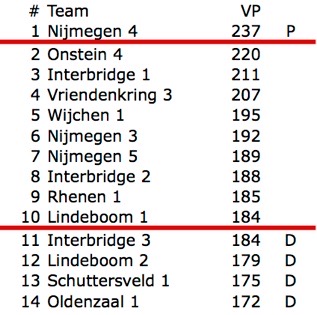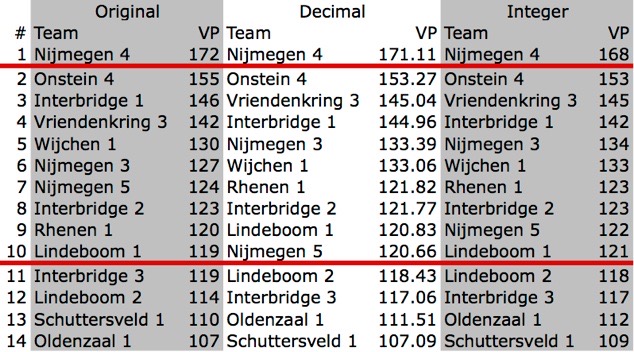 About a year ago, I wrote a blog on the new WBF IMP to VP conversion scale. The scale has now been used at several tournaments, time to evaluate it.
About a year ago, I wrote a blog on the new WBF IMP to VP conversion scale. The scale has now been used at several tournaments, time to evaluate it.
For those of you who don’t remember what this is all about: since the early 1980’s a 25-5 VP scale was used to assign VP’s in team matches (in round robins or swiss events). If the difference in imp is less than 4, both teams score 15 VP. (I’m assuming 24 board matches in this article, but the arguments don’t change for different numbers of boards.) If a team wins by 4, the score becomes 16-14, a bit more gives 17-13, all the way up to 25-5. At this point, the scores become 25-4, 25-3, ... until 25-0. This approach does have the disadvantage that not every imp counts. For example, winning a match by 8 or 9 imps scores 16-14. Winning by 10 suddenly scores 17-13. In the first case, the additional imp doesn’t matter, in the second case it does. One can consider this a fact of life or consider this unfair and try to fix it. The WBF scoring committee did the latter. They introduced a 20-0 scale with 2 decimals behind the comma. Suddenly 8 imp’s difference scores 12.07-8.93, 9 imp’s 12.30-8.70, 10 imp’s 12.53-8.47. Problem solved.
Problem solved? Not quite, as this doesn’t solve the problem that the imp scale itself is still discrete and not every trick always counts. Look at last year’s blog for an example. The second problem is publicity. People understand discrete numbers, results in 2 decimals are incomprehensible.
The scale has now been used at several tournaments, including the European open and junior championships. The publicity argument is indeed true, it becomes a lot less easy to understand the results, and journalists are struggling with the new numbers. One can argue that this takes time after using the 25-5 scale for 30 something years.
However, does the new scale actually change the results? Time for an experiment. Last year, I played in the national team competition. The format of this event is simple: 14 teams playing a round robin scored in VP’s. The winner gets promoted to a higher division, the bottom 4 teams are sent to the regional divisions.

First the official results using the 25-5 scale. It should be noted that Lindeboom 1 and Interbridge 3 scored the same number of VP’s, but the tie-break procedure was such that Lindeboom 1 finished 10th and thus that Interbridge 3 was demoted.
As I had the numbers in a spreadsheet, one can score the event again. This is shown in the table below for 3 cases. First the old 25-5 scale was modified by subtracting 5 VP from both results, resulting in a scale with an average of 10 VP. That obviously doesn’t change anything except that all teams get 65 VP’s less. Then the event was re-scored with the new decimal or continuous scale. The results are shown in the second column. Finally, the WBF did realize that in some cases integer numbers are to be preferred over decimal numbers, so they published a rounded-off version of the decimal scale. The results for that scale are shown in the third column.

The net result: the team that won, still wins in the 2 other cases. The teams that got demoted, still do so in the other cases. There are small changes in the middle of the field, but that is to be expected as the scores are really close here. Those changes do not matter anyway, the teams 2-10 do qualify for next year’s event regardless. Also note that the VP’s scored with the original scale minus the 65 VP offset are about the same as the one with the new integer scale, the differences are due to the rounding.
As Shakespeare would say: much ado about nothing.
Of course, this is only a single example. If you want to redo this for another event, my spreadsheet is available on request. And, as the WBF does not seem to plan an evaluation of the new scale, and the NBB has reprinted all its stationary for the next years, I’m now going stop complaining about this.
